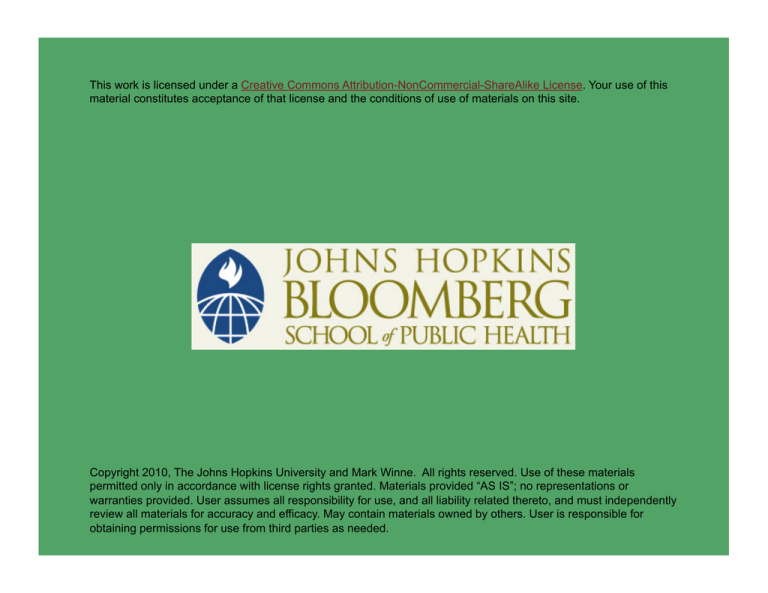
This work is licensed under a Creative Commons Attribution-NonCommercial-ShareAlike License. Your use of this
material constitutes acceptance of that license and the conditions of use of materials on this site.
Copyright 2010, The Johns Hopkins University and Mark Winne. All rights reserved. Use of these materials
permitted only in accordance with license rights granted. Materials provided “AS IS”; no representations or
warranties provided. User assumes all responsibility for use, and all liability related thereto, and must independently
review all materials for accuracy and efficacy. May contain materials owned by others. User is responsible for
obtaining permissions for use from third parties as needed.
Closing the Food Gap: A Historical
Review and Future Perspective
Mark Winne
Community Food Security Coalition
Mark Winne
Former executive director of the
Hartford Food System (1979 to 2003)
Community Food Security Coalition
-
-
Co-founder
Director of Food Policy Council
Project
Author of Closing the Food Gap
(Beacon Press, 2008)
Contact: win5m@aol.com;
505-983-3047; www.markwinne.com
3
Section A
History
Emergence: The 1960s
Hunger and poverty
Social, economic, and racial
disparities
Organic food
Environmentalism
5
Emerging Trends and Responses: The 1970s
Supermarket abandonment of urban and rural communities
Federal anti-hunger programs (food stamps)
Anti-poverty programs (Head Start)
Farmers’ markets, community gardens, food co-ops, etc.
6
Emerging Trends and Responses: The 1970s
Supermarket abandonment of urban and rural communities
Federal anti-hunger programs (food stamps)
Anti-poverty programs (Head Start)
Farmers’ markets, community gardens, food co-ops, etc.
7
Divergence: The 1980s
Decline in anti-poverty initiatives (Reagan)
Rise in food banks and other private charity
Growing interest in organic food and organic certification (60
Minutes exposé on Alar)
Organic and anti-hunger movements miss opportunity to work
together
Justice and sustainability go their own ways
8
Divergence: The 1980s
Decline in anti-poverty initiatives (Reagan)
Rise in food banks and other private charity
Growing interest in organic food and organic certification (60
Minutes exposé on Alar)
Organic and anti-hunger movements miss opportunity to work
together
Justice and sustainability go their own ways
9
The Food Gaps: 2009
Hunger and food insecurity (49
million)
Overweight, obesity, and dietrelated illness (65% overall; higher
in those with lower incomes)
Lack of food democracy
Food deserts (over 20 million
people; 800 rural counties)
Growth in organic food and
awareness of link between health
and diet
10
The Food Gaps: 2009
Hunger and food insecurity (49
million)
Overweight, obesity, and dietrelated illness (65% overall; higher
in those with lower incomes)
Lack of food democracy
Food deserts (over 20 million
people; 800 rural counties)
Growth in organic food and
awareness of link between health
and diet
11
Results: Trends Go Awry
Food relief (poverty management) takes priority over reducing
poverty
Calories more important than food quality
Fast food takes over; community development and wealth building
decline
Obesity and diabetes for many, local and organic for more
12




